Chapter 5: Newton's Laws of Motion
1/33
Earn XP
Description and Tags
These flashcards cover key vocabulary terms and concepts related to Newton's Laws of Motion and their applications, including forces, laws of motion, energy, and work.
Name | Mastery | Learn | Test | Matching | Spaced |
|---|
No study sessions yet.
34 Terms
Field Forces
no physical contact
Strong Force
Electromagnetic Force
Weak Force
Gravitational Force
Strong Force
within nucleus that holds protons
10^-15 m
Electromagnetic Force
between charges → made us
aware of interactions such as attraction and repulsion. The electromagnetic force is responsible for electricity, magnetism, and light.
Weak Force
radioactive processes → nuclear reaction in sun
10^-15 m
Gravitational Force
between masses
weakest of all
Newton's First Law of Motion
an object moves with a constant speed in a straight line unless a non-zero net force acts on it
moves with velocity constant in magnitude and direction
Net Force
The vector sum of all external forces exerted on an object
Newton’s First Law: air hockey puck example
without air, there’s friction
when friction is removed by air, it moves in a straight line at a constant speed until collision with another object
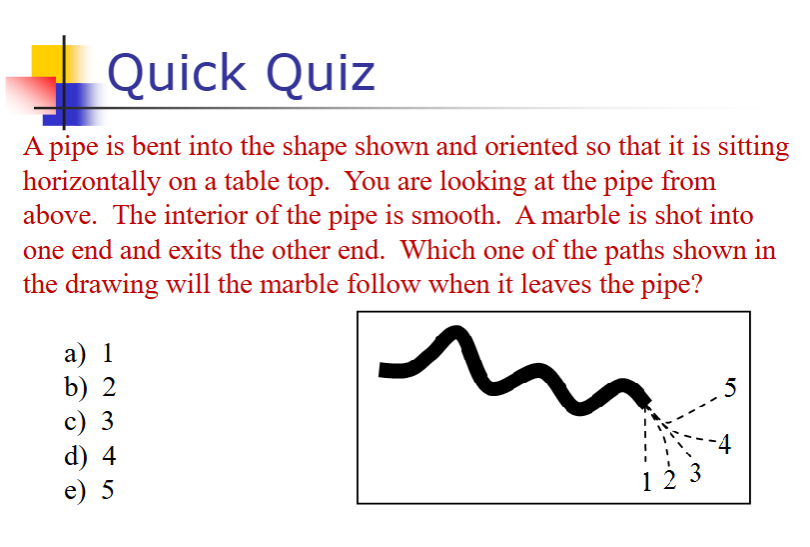
3 - in a straight line
Newton's Second Law of Motion
The acceleration of an object is directly proportional to the net force acting on it and inversely proportional to its mass (F = ma)
F & a are both vectors
Units of Force
The SI unit of force is the Newton (N), which is defined as the force required to accelerate a one-kilogram mass by one meter per second squared.
1 N = 1 (kg*m)/s²
US Customary unit of force is a pound (lb): 1 N = 0.225 lb
Which describes net force?
The quantity that changes the velocity of an object
Free Fall
The motion of a body when only the force of gravity is acting on it, with no air resistance.
F = ma
a = 9.8 m/s² → always constant
C = 2πr
C/d = C/2r = π
In a free fall, the greater the mass of the object…
the greater its force of attraction toward the earth
the smaller its tendency to move (the greater its inertia)
If F = 10, and m = 1 kg in a free fall, what is a?
F = ma
a = F/m = 10 N/1 kg = 10 m/s²
What explains why freely falling objects of various masses have the same accelerations?
Newton’s second Law
F/m = g, 2F/2m = g
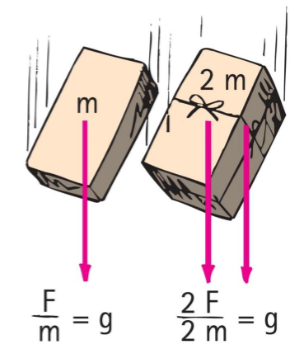
Weight
W = mg
special case of Newton’s 2nd Law where a = g = 9.8 m/s² due to gravity
Unit: N or lb (not kg)
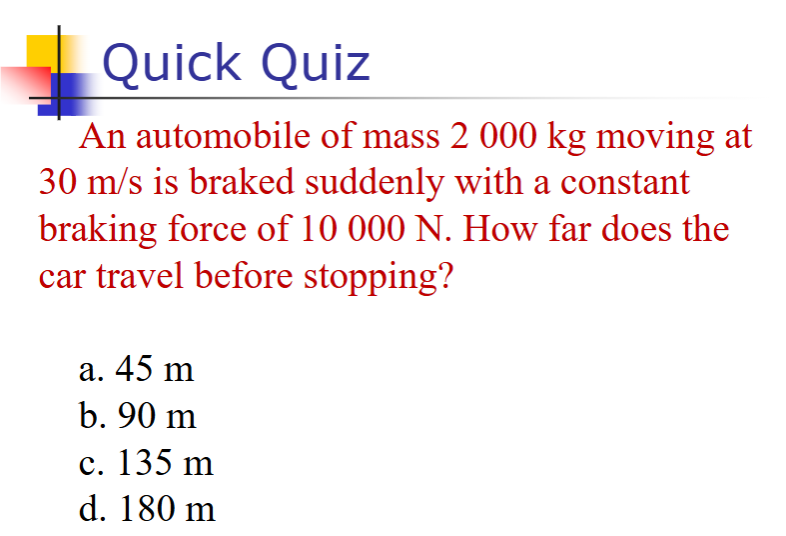
kinematic equations:
v = v0+at
Δx = v0t + ½ at²
v² = v0² + 2aΔx
F = ma
10,000 N = 2,000 kg (a)
a = 5 m/s²
Use kinematic equation: v² = v0² + 2aΔx
0² = (30 m/s)² + 2(5)Δx
(-30 m/s)² = 10Δx
Δx = 900/10 = 90 m
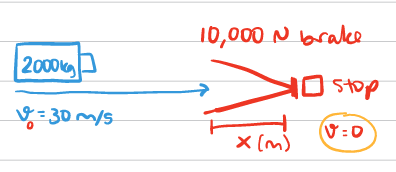
Newton’s Third Law of Motion
if object 1 & object 2 interact, the force exerted by object 1 on object 2 will be equal in magnitude but opposite in direction
action forces = (-)reaction forces
action: tire pushes on road, reaction: road pushes on tire
action: rocket pushes on gas, reaction: gas pushes on rocket

Action: earth pulls apple down, reaction: apple pulls earth up?
Yes, just not strong enough (mass apple = 1, earth = 10^(24))
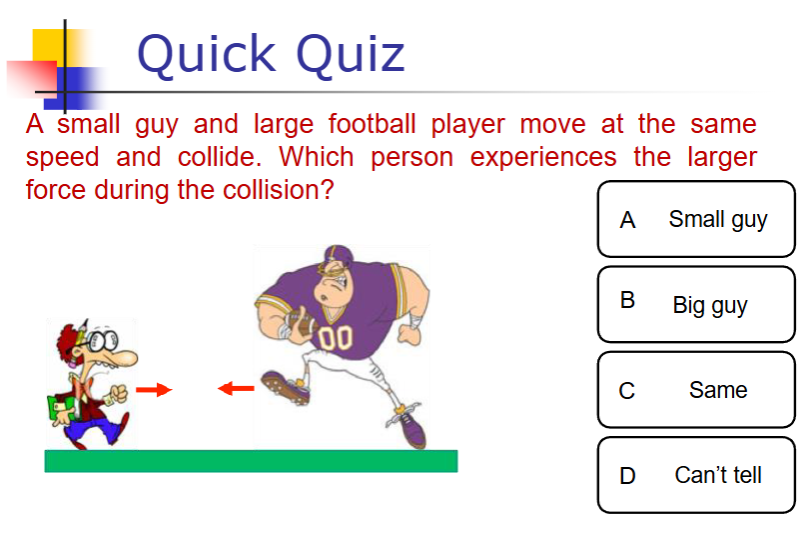
C: same
F will be equal & opposite, a will be different
Newton’s 2nd Law in Component Form
∑Fx = max
∑Fy = may
a = sqrt( ax2 + ay2); F = sqrt( Fx2 + Fy2)
According to Newton’s Second Law (Component Form), an object either at rest or with a constant velocity is…
at equilibrium
∑F = 0 because a = 0 when v = 0 or v = constant
net force acting on it is 0 because a = 0
Normal Force
The perpendicular force exerted by a surface to support the weight of an object resting on it.
example: force table exerts on tv
n’ is the reaction: the tv on the table
n = -n’
Tension
The force transmitted through a string, rope, or cable/cord when it is pulled tight by forces acting from opposite ends.
Cord is attached to a body and pulls on the body with a force T directed away from the body of mass and along the cord
The forces at the two ends of the cord are equal in magnitude
Friction
The force that opposes the motion of an object when it is in contact with a surface.
always in opposite direction to F (F is force applied)
Free Body Diagram
identifying all forces acting on an object
∑Fx = max
∑Fy = may
masses of strings or ropes are negligible
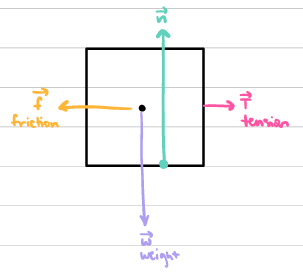
Weighing Machine
A device used to measure weight by balancing the gravitational force on an object against a known reference force, typically using springs or load cells.
measures normal force
∑Fy = may
n↑ (normal force) & w↓ (weight)
n - w = 0
n = w = mg
If the mass of a person on a weighing machine is 70 kg, what is the normal force exerted?
n = w = mg
n = 70 kg * 9.8 m/s² = 686 N (upward)
there is no horizontal (Fx) or acceleration because the person is standing still

What equations are relevant? If floor is frictional and if it’s not.
∑Fx = max
F = T
T = ma if floor is not frictional
T - f = ma if floor is frictional
∑Fy = may
no vertical movement, F = 0
0 = n - w
If a person pulls a block (m = 1000 kg) at a 30 degree angle, what expression would you use to find ∑Fx & ∑Fy ?
∑Fx = max
Tcos(30) - f = F
Tcos(30) - f = ma
∑Fy = may
n + Tsin(30) - w = F
no vertical acceleration
n + Tsin(30) - w = 0
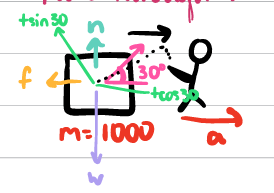
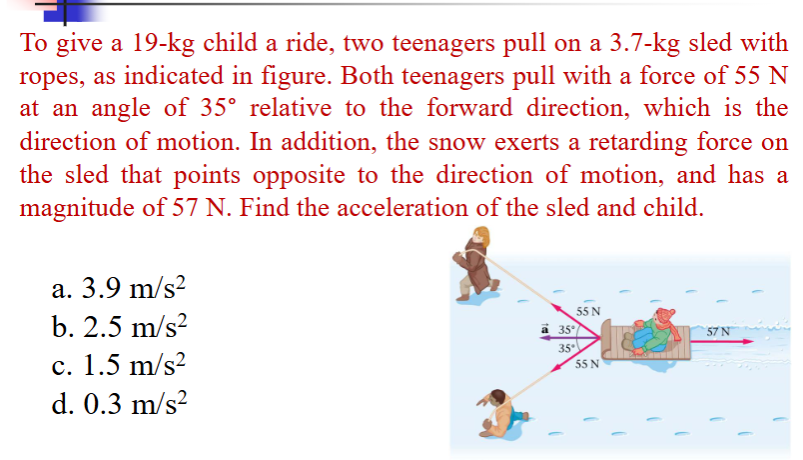
∑Fy = may = 0 BECAUSE they cancel out here
∑Fx = max
∑Fx = 2Tcos(35) - f
2Tcos(35) - f = max
2*55 N (cos(35)) - 57 N = 3.7 kg + 19 kg * a
a = 1.46 m/s²
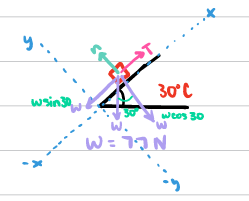
How do you approach an Inclined Planes problem?
choose coordinate system with x along incline and y perpendicular to incline
replace force of gravity with its components
∑Fx = max
Tcos(30) - f = ma
write it on the incline:
T - wsin(30) = 0
weight: n = wcos(30)
w = 100 lb - y
100cos(30) = 86.6 lb (we used 77 idk why)
T = wsin(30) = 77(1/2) = 38.5 N
∑Fy = may
n + Tsin(30) - w = 0
n = wcos(30) = 77cos(30) = 66.7 N
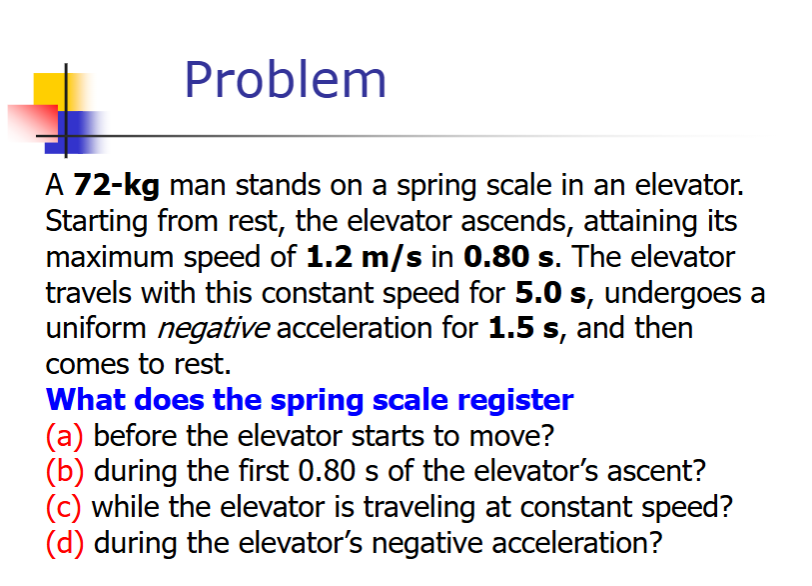
Before the elevator starts to move:
spring scale measures normal force (n)
Fn = mg = 72 kg * 9.8 m/s² = 720 N = 162 lb
1 N = 0.225 lb
During the first 0.80 s of the elevator’s ascent:
Draw FBD
∑Fy = may (only vertical movement)
F = n - w = ma
n = ma + w
n = ma + mg = m(a + g)
v = v0 + at
a = (v - v0)/t = 1.2/0.8 = 1.5 m/s²
n = 72 kg (1.5 m/s² + 9.8 m/s²) = 813.6 N
When elevator is traveling at a constant speed:
v = constant
n = m(g + a) → a = 0
w = same
n = mg = 720 N
During elevator’s negative acceleration:
a = (v - v1)/t = (0 - 1.2)/1.5 = -0.8
n = m(g + a) = 72 kg (9.8 m/s² - 0.8 m/s²) = 648 N